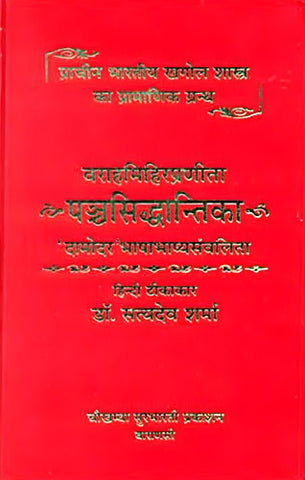Panchasiddhantika (Pancha Siddhantika)

Varāhamihira also called Varaha or Mihira, was an Indian astronomer, mathematician, and astrologer who lived in Ujjain.He is considered to be one of the nine jewels (Navaratnas) of the court of legendary ruler Vikramaditya thought to be the Gupta emperor Chandragupta II Vikramaditya. Arya Varāhamihira who Born 505 CE a...Read more
Description
Varāhamihira also called Varaha or Mihira, was an Indian astronomer, mathematician, and astrologer who lived in Ujjain.He is considered to be one of the nine jewels (Navaratnas) of the court of legendary ruler Vikramaditya thought to be the Gupta emperor Chandragupta II Vikramaditya.
Arya Varāhamihira who Born 505 CE and Died 587 CE.This Indian was a great Astronomer,Mathematician and well known Astrologer lived in the Gupta Era and as his notable works are the author of the Brihat Samhita and the Pancha Siddhantika. He travelled to the land of the Yavanas as well as Persia and translated the panchatantra into pahlavi at the request of the Persian king.
Varahamihira, also called Varahamira or simply Varaha, was one of the most celebrated scientists in South Asian history, having made substantial contributions to virtually all branches of the arts and sciences. Thus, Encyclopedia Britannica notes, "Varāhamihira of the Gupta age was a profound scholar of all the sciences and arts, from botany to astronomy and from military science to civil engineering." (Enc.Brit., "Education, History of," vol.18, p.4, 1990 ed.)
Born in Ujjain, the capital of the Scythian-dominated region now known as Rajputana, he wrote three important books: Panchasiddhantika, Brihat Samhita, and Brihat Jataka. Brihat Samhita is a compilation of an assortment of topics that provides interesting details of prevailing beliefs. Brihat Jataka is a book on astrology.
Contributions in Mathematics:
The most famous work by Varahamihira is the treatise on mathematical astronomy called the Pañca-siddhāntikā ("Five Astronomical Treatises") and dated 575 AD. It is a summary of five earlier astronomical systems, namely the Surya, Romaka, Paulisa, Vasistha and Paitamaha siddhantas. (
The Pancha Siddhantika are:
1. Sūrya-Siddhānta, ie. the Siddhānta of the Sun, composed by Lāṭa,
2. Vasishṭa-siddhānta, so called from one of the stars of the Great Bear, composed by Vishnucandra,
3. Pulisa-siddhānta, so called from Paulisa, the Greek, from the city of Saintra, which I suppose to be Alexandria, composed by Pulisa.
4. Romaka-siddhānta, so called from the Rūm, ie. the subjects of the Roman Empire, composed by Śrīsheṇa.
5. Brahma-siddhānta, so called from Brahman, composed by Brahmagupta, the son of Jishṇu, from the town of Bhillamāla between Multān and Anhilwāra, 16 yojanas from the latter place.The authors of these books draw from one and the same source, the book "Paithāmaha", so called from the first father, ie. Brahman." (Sachau 1964, vol.I, p.153)
The Arya-siddhanta, a lot work on astronomical computations, is known through the writings of Aryabhata's contemporary, Varahamihira, and later mathematicians and commentators, including Brahmagupta and Bhaskara.Varahamihira gives a reference to the day of Kuja (Mars). Mars is also called Kshiti – Tanaya (the sun of the earth).He says ths day is inauspicious whether the one who says so is an ordinary man or is Pitamaha (lit means grandfather.. in this context it means Brahma).
Varahamihira's other most important contribution is the encyclopedic Brihat-Samhita. It covers wide ranging subjects of human interest, including astrology, planetary movements, eclipses, rainfall, clouds, architecture, growth of crops, manufacture of perfume, matrimony, domestic relations, gems, pearls, and rituals.
Details of Book :-
- Author - Dr. Satyadev Sharma
- Publisher - Chaukhamba Surbharati Prakashan
- Language - Hindi , Sanskrit (Sanskrit Text And Hindi Translation)
- ISBN - NA
- Binding - Hardbound
- Pages - 456
- Size - 9 inches x 6 inches
- Weight of book - 600 grams










